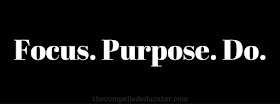At the end of 2013, I had an "aha" moment. I had been a long-time coach and believed in the power of positive words and messages. Until then, I had been setting new year's resolutions, usually to have them not met by the middle of January. I would feel like a failure, even though my brain was trained to use missteps as learning opportunities, I still felt like my goals were out the window before the season had even changed in the new year. I realized that even though I believed in mottos, words, and motivational phrases, I hadn't used them as a way to direct my yearly goals.
I had long admired Chris Brogan and Jon Gordon and their "words for the year," and in 2014 I decided to follow the model of Chris Brogan and choose 3 words to drive my thoughts, decisions, and actions for the year. The result? A wonderful year of "failures" and successes. Each success and failure became part of my journey within the parameters of my three words, and I had a much more meaningful, purpose-driven life.
Even after being called out by Jon Gordon in 2014, I stuck with choosing 3 words for 2015. The three words provide guideposts for me, especially when I want to become distracted or have to make difficult decisions. This past year has been a year of stepping outside of my comfort zone, creating flow and rhythm in my personal- and professional-life balance, and staying mentally, emotionally, and physically healthy.
"Taking action in alignment with your true values and your deepest desires is the key to a happy an meaningful life." -- Stacey Curnow
After much thought of what my goals are for 2016 and words that would be meaningful and powerful to me, I want to share them with you here as part of my accountability.
The first of my words is FOCUS. I have a very curious brain, and I usually have several projects going at once. I love learning, teaching, and sharing, and I've been told my brain is like a pinball machine inside my head. While I enjoy the pace and challenge of having several things going at once, I want to really do a deep dive into meditation and focus, and make sure that I am giving my very best to each project that I'm a part of.
Another of my 3 words for 2016 is PURPOSE. Sometimes I have a hard time saying no (see FOCUS above), even when my actions would not be purposeful for others or myself. I want to make sure that in 2016 I examine all that I do so that I am bringing good into the world that is purposeful and impactful. While I am a very positive person, I want my actions to also have meaning and purpose for others and myself.
The third word for 2016 is DO. For me, this means "just take action." There are so many times that I don't know how to do something or I fear that if I do something it will be wrong, and it prevents me from doing. Not in 2016. I'm going to go for it. Whether it's trying something new with technology, sharing a new PD idea with staff, planning a road trip for my family, or building new furniture for my home... I'm going to take action. Be forewarned... I may try to drag you on my journey of doing, too. :-)
When Jon Gordon asked me to narrow down my three words into one, I chose INTENTIONAL, as it undergirded the other two words of Discipline and Balance for 2014. For 2015, BRAVERY would have been my one word, as it would allow me to step out of my comfort zone to create Rhythm and Fitness in my life.
As I review the three words for the new year, I truly have a hard time narrowing it down to only one word. I would say DO, but I don't want my actions to be without focus or purpose. So for 2016, I'm definitely choosing three words to light my path.
I would love for you to share your one or three words in the comments and connect on Twitter or Voxer (@jennifer_hogan).




















